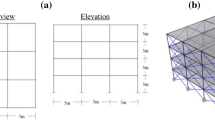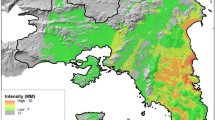Abstract
This paper presents the construction classification of the existing engineering covers in Taiwan. The exposure profile and variable vulnerability during different construction phases are established for some kinds of classes of construction. Finally, we present a method and framework to estimate the probable maximum loss of engineering insurance portfolio during an earthquake with consideration of the dynamic nature of structural changes and exposure values during a construction project.





Similar content being viewed by others
References
ATC-13 (1985) Earthquake damage evaluation data for California. Applied Technology Council
Chen CW (2004) Stability analysis of T-S fuzzy models for nonlinear multiple time-delay interconnected systems. Math Comput Simul 66:523–537
Chen CW (2006) Stability conditions of fuzzy systems and its application to structural and mechanical systems. Adv Eng Softw 37:624–629
Chen CW (2009) Modeling and control for nonlinear structural systems via a NN-based approach. Expert Syst Appl 36:4765–4772
Chen CW (2010a) GA-based adaptive neural network controllers for nonlinear systems. Int J Innov Comput Inf Cont 6:1793–1803
Chen CW (2010b) Stability analysis of an oceanic structure using the Lyapunov method. Eng Comput 27:186–204
Chen CW (2010c) Application of fuzzy-model-based control to nonlinear structural systems with time delay: an LMI method. J Vib Control 16:1651–1672
Chen CY (2010d) Fuzzy control for an oceanic structure: a case study in time-delay TLP system. J Vib Control 16:147–160
Chen CW (2011) Stability analysis and robustness design of nonlinear systems: an NN-based approach. Appl Soft Comput 11(2):2735–2742
Chen CW (2012a) A novel strategy to determine the insurance and risk control plan for natural disaster risk management. Nat Hazards. doi:10.1007/s11069-012-0305-3
Chen CY (2012b) Assessment of the major hazard potential of interfacial solitary waves moving over a trapezoidal obstacle on a horizontal plateau. Nat Hazards 62(3):841–852
Chen CW (2012c) Hazard management and risk design by optimal statistical analysis. Nat Hazards. doi:10.1007/s11069-012-0329-8
Chen CW (2012d) A new viewpoint of hazard assessment and management for Taiwan’s insurance issues. Nat Hazards. doi:10.1007/s11069-012-0363-6
Chen CY (2012e) Disaster prevention and reduction for exploring teachers’ technology acceptance using a virtual reality system and partial least squares techniques. Nat Hazards 62(3):1217–1231
Chen CW, Tseng CP (2012) Default risk-based probabilistic decision model for risk management and control. Nat Hazards 63(2):659–671
FEMA (1997) Earthquake loss estimation methodology: Hazus99. Technical Manual 3
Haque CE, Etkin D (2007) People and community as constituent parts of hazards: the significance of societal dimensions in hazards analysis. Nat Hazards 41(2):271–282
Hsiao FH, Chen CW, Liang YW, Xu SD, Chiang WL (2005a) T-S fuzzy controllers for nonlinear interconnected systems with multiple time delays. IEEE Trans Circuits Systs-I Regul Pap 52:1883–1893
Hsiao FH, Hwang JD, Chen CW, Tsai ZR (2005b) Robust stabilization of nonlinear multiple time-delay large-scale systems via decentralized fuzzy control. IEEE Trans Fuzzy Syst 13:152–163
Hsu WK (2000) The development of the integrated multi-objective seismic hazard assessment system, Doctoral Dissertation, National Central University
Hsu WK (2011) An integrated flood risk assessment model for property insurance industry in Taiwan. Nat Hazards 58(3):1295–1309
Hsu WK (2012) Risk and uncertainty analysis in the planning stages of a risk decision-making process. Nat Hazards 61(3):1355–1365
Huang TK (2008) Study of S-curve model for bridge construction projects. Master Thesis, National Kaohsiung First University
Lauras M, Marques G, Gourc D (2010) Towards a multi-dimensional project performance measurement system. Decis Support Syst 48:342–353
Lin ML (2011) Using GIS-based spatial geocomputation from remotely sensed data for drought risk-sensitive assessment. Int J Innov Comput Inf Cont 7(2):657–668
Lin JW (2012a) Kalman filter decision systems for debris flow hazard assessment. Nat Hazards 60(3):1255–1266
Lin JW (2012b) Modeling and assessment of bridge structure for seismic hazard prevention. Nat Hazards 61(3):1115–1126
Lin JW (2012c) Potential hazard analysis and risk assessment of debris flow by fuzzy modeling. Nat Hazards 64(1):273–282
Lin CW (2012d) The construction of a high-resolution visual monitoring for hazard analysis. Nat Hazards. doi:10.1007/s11069-012-0409-9
Mike G (2007) Time to construct a better. Publication, JIT Re
Raaijmakers R, Krywkow J, van der Veen A (2008) Flood risk perceptions and spatial multi-criteria analysis: an exploratory research for hazard mitigation. Nat Hazards 46(3):307–322
RMS (2007) Builder Risk Brochure
Shih BY (2012) Using Lego NXT to explore scientific literacy in disaster prevention and rescue systems. Nat Hazards. doi:10.1007/s11069-012-0233-2
Shinozuka M, Feng MQ, Lee J, Naganuma T (2000) Statistical analysis of fragility curves. J Eng Mech 126(12):1224–1231
The World Bank & Columbia University (2005) Natural diaster hotspots: a global risk analysis. Hazard Management Unit, The World Bank, Washington, DC
Tsai CH (2010) An earthquake disaster management mechanism based on risk assessment information for the tourism industry: a case study from the island of Taiwan. Tour Manage 31(4):470–481
Tsai CH (2011a) Development of a mechanism for typhoon and flood risk assessment and disaster management in the hotel industry: a case study of the Hualien area. Scand J Hospital Tour 11(3):324–341
Tsai CH (2011b) The establishment of a rapid natural disaster risk assessment model for the tourism industry. Tour Manage 32(1):158–171
Tsai CH, Chen CW (2010) An earthquake disaster management mechanism based on risk assessment information for the tourism industry: a case study from the island of Taiwan. Tour Manage 31(4):470–481
Tseng CP (2011) A new viewpoint on risk control decision models for natural disasters. Nat Hazards 59(3):1715–1733
Tseng CP (2012) Natural disaster management mechanisms for probabilistic earthquake loss. Nat Hazards 60(3):1055–1063
Tseng CP, Chen CW, Liu FR (2012) Risk control allocation model for pressure vessels and piping project. J Vib Control 18(3):385–394
Yang HC (2012) Potential hazard analysis from the viewpoint of flow measurement in large open-channel junctions. Nat Hazards 61(2):803–813
Zhou HJ, Wang JA, Wan JH et al (2010) Resilience to natural hazards: a geographic perspective. Nat Hazards 53(1):21–41
Acknowledgments
The authors would like to thank the SINOTECH Engineering Consultants. INC and National Science Council of the Republic of China, Taiwan, for their financial support of this research under Contract Nos. 100-2221-E-022-013-MY2 and 100-2628-E-022-002-MY2.
Author information
Authors and Affiliations
Corresponding author
Rights and permissions
About this article
Cite this article
Hsu, WK., Chiang, WL., Xue, Q. et al. A probabilistic approach for earthquake risk assessment based on an engineering insurance portfolio. Nat Hazards 65, 1559–1571 (2013). https://doi.org/10.1007/s11069-012-0425-9
Received:
Accepted:
Published:
Issue Date:
DOI: https://doi.org/10.1007/s11069-012-0425-9




